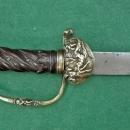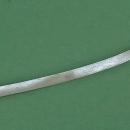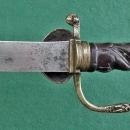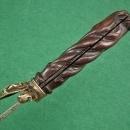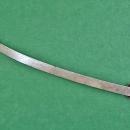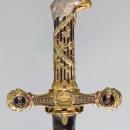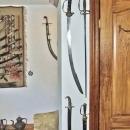Antique 18th Century Polish Sword Eagle Saber 1713 Augustus II The Strong








$15,000.00
This unique antique, from the early 18th century, is a Polish sword saber with an eagle-form hilt—Szabla Orla (Eagles saber). It is dated 1713.
Massive, very well hand-forged curved single-edged steel blade is with a pronounced false edge Yelmen and chased on both sides of the forte with the date 1713.
This blade is in typical Polish form, often found in 17th-18th century Polish karabela swords.
The elaborated hilt consisted of a massive, finely carved hardwood grip with a swirled grasp extending from a base carved with a Royal Crown to a large pommel shaped like a Polish heraldic eagle head with a prominent massive beak and bared eyes.
Two iron rivets secure the grip to the tang of the blade.
The brass hilt consists of a downturned shell guard that is hand-sculpted in relief. The scene depicted on it shows a muscular man lying under a tree with an oval shield beside him, mourned by a woman and a small child.
This scene serves as an analogy to the classical Greek Spartan phrase, "Come back with your shield, or on it." According to ancient Spartan tradition, a warrior was always with his shield—either returning home from battle alive while carrying it or dead, being carried by his comrades.
Spartan mothers were said to encourage their sons to "come back with your shield, or on it" before they went into battle. Returning without the shield was considered cowardly and unacceptable.
When a Spartan soldier was killed in battle, their body would indeed be carried home on top of their shield. This allowed the fallen warrior to be transported with dignity and honor, even in death. The shield provided a sturdy surface to carry the body, and the visual of the slain soldier on their shield was a powerful symbol of their bravery and sacrifice.
The knuckle bow with ferrule and a chiseled bulbous rear quillon is adorned in the middle with a hand- chiseled in relief figure of a small child, the same as that depicted on a shell guard.
The tradition of Polish swords with eagle head hilts dates to the late 15th century. The oldest documented Polish iconography depicting the sword with the eagle pommel can be found in the Gothic Wit Stwosz altarpiece in St. Mary's Basilica in Kraków, sculpted in 1477-1489 as part of a scene depicting Christ's capture. Another early depiction of an eagle-headed sword appears on the marble tombstone of Brothers Stanisław and Janusz III, Dukes of Masovia, at St. John's Archcathedral in Warsaw, sculpted in 1526-1528, where a sword with an eagle's head is shown at Prince Janusz's side.
In a 17th-century portrait of King John II Casimir Vasa (Polish: Jan II Kazimierz Waza), the King is shown holding a sword with a swirled grip and an eagle-head pommel, which is identical to our sword.
Please see the picture in the listing.
Additionally, in a portrait of King August III in Polish costume by Louis de Silvestre, the King is also depicted with a similar eagle-pommel sword.
Please see the link below:
https://upload.wikimedia.org/wikipedia/commons/7/73/King_August_III_in_Polish_costume_by_Louis_de_Silvestre.jpg
Other well-known examples of Polish swords with eagle heads are:
1. Late 16th-century Polish sword in the Polish Army Museum Warsaw.
2. Sword of The Polish King John III Sobieski.
3. The Coronation sword of King Stanislaus Augustus Poniatowski in 1764 features a pommel almost identical to the pommel on our sword and a grasp extending from a base carved with a Royal Crown. So, it is quite possible that the hilt of our saber served as a model for the hilt of the coronation sword of King Stanislaus Augustus Poniatowski.
Please see the penultimate picture in the listing.
Also, the most famous Polish sword, Karabela features a pommel shaped like an eagle head.
During the 19th century, Polish swords with eagle pommels were crafted for the officers of the Army of the Duchy of Warsaw (1807–1815) and the officers of the Army of the Duchy of Warsaw and The Army of The Kingdom of Poland (1815-1830).
Renowned swordsmith Ignacy Höfelmajer (1825-1889) crafted some luxurious karabela swords with metal eagle head pommels in Krakow.
Later in the 20th century (1920-1939), the swordsmith G. Borowski in Warsaw produced presentation swords with eagle heads.
For over 1000 years, the eagle has been a heraldic symbol of Poland. According to legend, the White Eagle emblem originated when Poland's founder, Lech, saw a white eagle's nest. As he observed the bird, a ray of sunshine from the red setting sun fell on its wings, giving the appearance of them being tipped with gold, while the rest of the eagle was pure white.
The sword's hilt is decorated with the symbols of the Polish Kingdom, including an eagle head and the King's crown. This suggests that the sword may have belonged to King Augustus II The Strong, who was the King of Poland and Grand Duke of Lithuania from 1697-1704 and 1709-1733.
It's unlikely that an ordinary Polish nobleman or even a Polish aristocrat would have owned a saber with a hilt decorated with Polish national emblems, a Polish heraldic eagle, and the royal crown.
This sword's hilt bears a striking resemblance to the hilt of John II Casimir Vasa's sword in a 17th-century portrait and to the hilt of King Stanislaus Augustus Poniatowski's Coronation sword.
Furthermore, the shell guard has a very unusual and symbolic décor, referring to the tradition of ancient Sparta and the date engraved on the blade, 1713. This symbolism fits perfectly into the Great Northern War (1700–1721) in which the King Augustus II, The Strong, participated.
Augustus II, known as "the Strong," "the Saxon Hercules," and "Iron Hand" due to his impressive physical strength, was known for demonstrating his might by breaking horseshoes with his bare hands and participating in fox tossing, where he held one end of the sling with just one finger while two of his court's strongest men held the other end.
The combat sword in question has an exceptionally long, heavy blade, a large hilt, and a huge grip. Due to these specifications, the sword would only be effective in the hands of a strong man with large hands. I have been familiar with various sabers for decades, but this is the first time I have encountered one with such dimensions, especially the handle size.
I attempted to perform various saber-cutting movements for three minutes, but unfortunately, I found it challenging. This was because I couldn't properly grip such a large handle. Please refer to the last picture in the listing for more details.
CONDITION: The sword is in very good condition, considering its age is over 311 years old.
Please see all pictures in the listing since they are part of the object's condition description.
To view all the pictures please see the link below.
https://www.antiquesword101.com/European-Arms-and-Armor.php#!/Antique-18th-Century-Polish-Sword-Eagles-Saber-1713-Augustus-II-The-Strong/p/684412621/category=3736929
MEASUREMENTS:
Overall length: 93 cm (36.61 inches).
Length of the blade: 77.5 cm (30.51 inches).
Width of the blade at the widest point: 3.8 cm (1.5 inches).
Thickness of the blade at the spine: 5 mm (0.197 inches).
Total weight: 814 grams (1.795 lb.)
REFERENCES:
"Światła Stambułu" by Zdzisław Żygulski jun: chapter Karabela i szabla orła. Page 213.
We will also provide the buyer with photocopies of the pages from the mentioned references together with a certificate of authenticity.
PROVENANCE:
We acquired this sword together with other Polish antiques, including antique Polish arms and armor from the old Canadian collection, probably the largest in North America, built for over 40 years.
We have attached to the listing a photo showing this sword together with other Polish swords from this collection (the fourth sword from the right. Please see the last picture in the listing.
Please view our store contents to see other rare objects from this collection.
